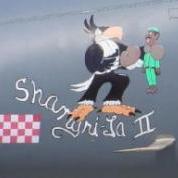Everything posted by Hacker
-
Leather Flight Jacket
Anyone have favorite locations to get cuffs and waistbands on their jacket replaced (outside of Pop's)?
-
The Rise and Fall of Captain Holly Graf (USN)
And, of course, when all else fails, drop the sexual harassment/discrimination/etc charge.
-
10 year commitment.
I think the core issue here is a widespread problem of expectation (and entitlement) management on the part of the rank-and-file. In other words, people feel like they're entitled to a lot more than Big Blue ever 'promised' or even implied. It's been nearly 20 years since the era of banked pilots, RIFd officers, etc, from the early 90s drawdown period. We should ALL be well aware that such measures can be taken, and that we will have virtually no recourse if it happens. Wanna talk about getting shafted? Hundreds of those guys got fucked Long Dong Silver-style and for most of them it came out of nowhere. We don't have that luxury of ignorance and can't be the wide-eyed doe when the shot seemingly comes out of nowhere, because we SHOULD all know what the possibilities are. I agree that it would suck to get some of the bad deals I've read about here, heard about at the bar, and seen around the AF. But, let's face it -- there are LOTS of people who get 'screwed' all the time. If it hasn't happened to you at some point in your career, chances are it will. If you make it all the way to retirement and haven't gotten the shaft by Big Blue at some point, consider yourself lucky because you're in the vast minority. Bottom line, bros, getting screwed by Blue is simply part of the job description. Embrace it, or you'll end up living a pretty unhappy couple of years in the service.
-
10 year commitment.
That does suck. Reading the above (and from a fighter guy's perspective) I'm surprised at what's happened with respect to your job/assignment progression. In the fighter community, a 1st assignment dude who made IP would have a pretty high strat, regardless of being deployed a ton or not. Naturally, I have no idea about how it works in the heavy circles -- obviously things are different (and apparently for the worse, IMHO). Don't get me wrong, you appear to have gotten a pretty shitty deal (it would have been nice to know all that to get some perspective on your previous rants), but you shacked it in your 2nd to last sentence -- Blue doesn't owe any of us jack shit (good or bad). And, you're right...when your ADSC is up, you should punch with pride and not let anyone give you the slightest bit of lip about it.
-
10 year commitment.
I think you need to go actually read the terms of the "contract" before making such a statement/argument.
-
AF Light Air Support Aircraft
He's got a little bit of a strange theoretical implementation plan. This whole idea supposes that there is some kind of excess time and manpower in the F-15E world that could be filled by the addition of OA-X. In my experience, F-15E squadrons, just like every other squadron, struggle to fill the flying lines that they have while maintaining their queep at the same time. Guys are all ready flying their asses off -- it wasn't unusual on my latest tour to see guys tag 1,000 hours on their FIRST FLYING TOUR because of all the deployment flying. That was completely unheard of during my first spin through the F-15E community. In short, there's not some lack of flying that's plaguing the community that could be filled by OA-X. On top of that, aircrew qualification and proficiency would be a nightmare. It is tough enough to stay somewhat "proficient" in all of the various missions and weapons we all ready have, especially given the current spinup-deployment-reconstitution-upgrades cycle. Again, the author supposes the creation of two separate classes of crews...I think he'd find that there all ready is such a division, and those lesser qualified crews are called "attached" and filling those OSS, Group, and Wing jobs while staying BMC in the squadron instead of CMR. To add a completely different aircraft, and all of it's missions and weapons, into the mix will dilute the capabilities of both aircraft.
-
10 year commitment.
So, you were a FAIP and then you were assigned to UAvs?
-
10 year commitment.
That's seriously your answer to me when you later say, Yes, exactly. None of us were drafted -- we all volunteered. Everyone -- EVERYONE -- knows the score when they sign on the dotted line. Anyone who claims they didn't know are either ignorant or in denial. Too many completely lose that perspective. Not willing to serve in that UAV job? Shoulda stayed a civilian, because everyone knows the bottom line when they sign up to be in service to Uncle Sam. All of us who are line officers, when it comes down to it, can do anything up to and including grabbing the rifle and charging the machine gun nest. We ALL serve at the pleasure and convenience of our leadership, and it's not Burger King where you can "have it your way". Career hasn't gone the way you wanted? Boo-fucking-hoo -- join the club. It's called "the service" because it ain't about you.
-
10 year commitment.
So much for "Officers First".
-
Customs and courtesies
The irony of it all... The last time I ran into any "customs and courtesies" issue was at Bagram, and it was with an Army 1Lt and some kind of senior NCO. I was in my AF PT gear walking to the chow hall, and walked past said 1Lt and Senior NCO. As I passed them, the NCO said (to nobody in particular, but loud enough to make it obvious that I was the target), "I guess they don't salute OFFICERS in the Air Force any more!". I stopped walking...pondered for a second if they were actually talking to me, and when I turned around they were both staring at me as if expecting me to genuflect and apologize to this obviously disrespected Army officer. Then, I thought, 'naaah...can't be ME they're talking to...why would they assume that I was either enlisted or a 2Lt?' Regardless, I fished my ID card out, walked up smartly to the senior NCO and held it about 4 inches from his eyeballs, saying, "No...in the Air Force, we don't salute officers that are two ranks lower than we are." I wish there were a better slam-dunk end to the story, but what really happened was the NCO's sails deflated, he sheepishly said, "oh, sorry sir," saluted, and turned around to walk away. I've never had any problem with any enlisted folks outside the AF, actually. It's the Airmen in our very own blue service who all seem to think we're all equal, regardless of what we're wearing on our sleeves or collars/epaulets. The ones who feel they need to shout at me across the parking lot that it's against the uniform reg to have my flight suit sleeves pushed up....
-
New AF Motto
We'd all be better off if we acknowledged and embraced that our whole damn service is support...and that's okay.
-
Air Force Reinstate Captain Selection Boards
Right or wrong, regardless, that's how it happened for me, and the document is there to prove it.
-
Air Force Reinstate Captain Selection Boards
You sure about that? I went to my Capt board in '98 and I most definitely had a PRF written. I never saw it until well after the fact...it was handled all at the CC/exec level in my squadron, I only got my hands on a copy purely by accident (a copy was in my PIF and I saw it when I PCSd). It would be very entertaining to sit on a promotion board and sort out which officers sucked the most. I'll bet those would be some very interesting PRFs to read!
-
Air Force Reinstate Captain Selection Boards
I don't think that has ever been a consideration in ANG/AFRES hiring. I wouldn't expect it to start now.
-
Air Force Reinstate Captain Selection Boards
What possible motivation would an ANG or Reserve unit have to hire a passed over 1Lt??
-
Air Force Reinstate Captain Selection Boards
Considering that it used to be done up until 2002, what's the difference? I have my "Capt PRF" and it looks nothing like the meticulously thought out and wordsmithed document that my O-4 and O-5 PRFs looked like. Unless Commanders decide that they're going to put that type of effort into it (which, clearly, isn't required based on the promotion rate) then that's their own doing.
-
Bagram DFAC sets the fail bar
You should have told him you're responsible for making sure the pilots do their job correctly.
-
Back Stabbing
Good, hopefully that's an indication that there's been a change.
-
Back Stabbing
Sure...every time there was a "cooperate and graduate" moment, many stud WSOs were looking over their shoulder and waiting for the cheating police to bust down the door. I had more than one stud WSO report to me that there had been "cheating" during the academics. My response was, #1 are you really in here ratting out your bros, and #2, it's not cheating when the academic instructor gives you a 35-point review just minutes prior to proctoring the 35-point academic test. Obviously this doesn't describe *every* WSO who I saw go through IFF...not by a long shot. But there were certainly more moments like this from the Navy-trained folk than from the USAF-trained folk. What is it you're disagreeing with? Were you/are you an IFF instructor? I never went through Pensacola, but I sure saw plenty of the product of Pensacola that came through IFF on their way to the F-15E, and that's how I formed the opinion I posted.
-
Back Stabbing
The biggest problem with WSOs going through IFF is that they've been raised in the Navy's NFO training system up to that point, which has absolutely no "cooperate and graduate" aspect to it.
-
Back Stabbing
It's been the rare exception in my experience. What I've seen in the AF is absolutely childsplay compared to the walk-on-your-bros culture that exists in the O-3 and O-4 ranks in the Navy as they compete for promotions. Really, there are far greater cancers in the AF culture than backstabbing.
-
C-17 Down on Elmendorf
It's usually the sucker-punch to the gut when seeing such stuff that makes a lasting impression.
-
Headset questions
Weren't the Balad airframes all retrofitted aircraft that were purchased off the commercial market? I'm wondering if the custom-built 350ERs that make up the bulk of the fleet now had the civilian stuff left out.
-
Headset questions
Anybody know what the MC-12 guys are flying with? Are they using civil-impedance headsets, or does the airplane use single-plug military impedance headsets?
-
MC-12 Training and Center Thrust Restriction
This is what I did mine in; a relatively nice 2000 PA-44.



